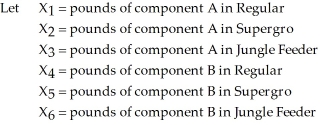Three types of fertilizer are manufactured by a company: Regular, Supergro, and Jungle Feeder. Regular should have at least 10 percent nitrogen and 16 percent phosphorous. Supergro should have at least 12 percent nitrogen and 20 percent phosphorous, and Jungle Feeder should have at least 15 percent nitrogen and 18 percent phosphorous. These are made by using two components: A and B. Component A costs $0.30 per pound and is 14 percent nitrogen and 18 percent phosphorous. Component B costs $0.50 per pound and is 20 percent nitrogen and 24 percent phosphorous. The demand for Regular is projected to be 1,000 pounds, while each of the others has a demand of 2,000 pounds. Formulate the appropriate linear program. 
Definitions:
Milkweed Plants
Plants known for their toxic sap, which provides protection against herbivores and is utilized by monarch butterflies during their development.
Endosymbionts
Organisms that live within the body or cells of another organism in a mutualistic relationship.
Energy Conversion
The process of changing one form of energy into another, such as solar energy into electrical energy.
Organelles
Specialized structures within a cell that perform specific functions, such as mitochondria and chloroplasts.
Q9: Bastille College is going to purchase new
Q23: Which of the following is not a
Q34: According to Table 10-1, which presents an
Q46: The first step in the maximal-flow technique
Q55: Consider the following linear programming problem: <img
Q56: Any time that we have an isoprofit
Q59: An ingredient or blending problem is a
Q65: Qualitative models attempt to incorporate judgmental or
Q83: Briefly describe the maximal-flow technique.
Q92: Which of the following is not a